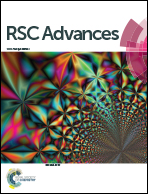Fabrication and characterization of ALK1fc-loaded fluoro-magnetic nanoparticles for inhibiting TGF β1 in hepatocellular carcinoma†
Abstract
Fluoro-magnetic nanoparticles play an important role in biomedical applications since their size and concentration in tumors allow a very high resolution and an accurate mapping of lesions. Fluorescein isothiocyanate (FITC) has been entrapped inside crystals of magnetic nanoparticles (MNPs) during crystallization. This causes changes of nanoparticle crystal architecture towards elongated rods. TEM and SEM-EDX show elongated crystals with high iron concentration. The intensity of fluoro-MNP fluorescence was detected by fluorescence spectrophotometry and confocal microscopy. The benzene ring structure of FITC and its carboxylic group were clearly detected in the fluoro-MNP spectrum by using FTIR, compared to MNPs prepared in the absence of FITC. Rods were functionalized by hydrogel cross-linking structure (PEG-CMC) onto the fluoro-MNPs surface by using alternate layer-by-layer (LbL) adsorption. These hydrogel properties are used as a preserver for protein delivery. ALK1fc as specific TGFβ1 inhibitor, was encapsulated inside (PEG-CMC) layers during LbL assembly. Zeta potential measurement, X-ray diffraction and SDS PAGE-silver staining results confirmed the encapsulation of ALK1fc. The efficiency of encapsulated ALK1fc was quantified by immunofluorescence assay against localization of TGFβ1. Stained TGFβ1 appeared a purple color and is distributed in the cytoplasm of untreated HLF (a liver cancer invasive cell line), whereas it disappeared in a HLF sample treated with encapsulated ALK1fc.



 Please wait while we load your content...
Please wait while we load your content...